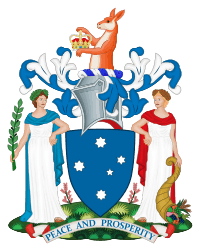Supreme Court of Victoria
| Supreme Court of Victoria | |
|---|---|
|
Arms of the Supreme Court of Victoria | |
| Established | 1852 |
| Country |
|
| Location | Melbourne |
| Coordinates | 37°48′51″S 144°57′29″E / 37.814132°S 144.957932°ECoordinates: 37°48′51″S 144°57′29″E / 37.814132°S 144.957932°E |
| Composition method | Appointed by Governor on the advice of the Executive Council. |
| Authorized by | Victorian Constitution |
| Decisions are appealed to | High Court of Australia |
| Judge term length | mandatory retirement by age of 70 |
| Number of positions | 37 |
| Website | www.supremecourt.vic.gov.au |
| Chief Justice of Victoria | |
| Currently | Marilyn Warren |
| Since | 26 November 2003 |
The Supreme Court of Victoria is the superior court for the State of Victoria, Australia. It was founded in 1852, and is a superior court of common law and equity, with unlimited jurisdiction within the state. Those courts lying below it include the County Court of Victoria and the Magistrates' Court of Victoria. The Victorian Civil and Administrative Tribunal, which is not a court, serves a judicial function. Above it lies the High Court of Australia. This places it around the middle of the Australian court hierarchy. The building itself is on the Victorian Heritage Register.
Architecture
Introduction
The Supreme Court of Victoria is part of a complex known as the Melbourne Law Courts, and is located at 192 William Street Melbourne, Victoria. The design for the building was the winning entry for a competition conducted by the Public Works Department.[1] The building design was revealed in 1873, and designed in a neo classical style, with construction carried out between 1874–82. The architects were the English immigrant duo Alfred Louis Smith (1830–1907) and Arthur Ebdon Johnson (1859–95) of Smith and Johnson.[2] In 1851 Victoria separated from New South Wales and became an independent colony complete with its own Constitution and judicial institutions. The Supreme Court of Victoria signifies the formation of these institutions and the preservation of the Constitution in Victoria. The mid 19th century Victorian Gold Rush financed the construction of many grand public buildings. The Supreme Court exemplifies this though its Renaissance Revival Style on an imposing scale. It is architecturally significant for being part of the largest court buildings in Australia constructed to a single design. The planning behind the functional division of different groups of courts was unparalleled.[1][2]
Description
The Supreme Court of Victoria is located on the corner of Lonsdale and William Streets, Melbourne; adjacent to the Melbourne Magistrates' Court and the County Court of Victoria. These buildings known collectively as the Melbourne Law Courts comprise a complex of two story brick constructions, resting on a Malmbury bluestone and Tasmanian freestone base.[1] The combination stone base is acknowledged for the expert masonry craftsmanship used in its construction. The site is contained within a square block with a court positioned at each of its corners. Additional courts are located along the lateral, north and south wings. Administration offices and Judges Chambers enclose a circular central courtyard from which rises the Supreme Court Library with its central tower and dome.
Key influences and design approach
Johnson and Smith were English immigrants who designed public buildings in a Classical style. Their design for the Melbourne Supreme Court is no exception, and draws on the style of Renaissance revival architecture. The Library tower is particularly expressive of this style with its three floors appropriating to form a base, piano nobile and attic story. A former Chief Justice, Sir William Stawell, suggested that the building may have had design origins in James Gandon's Four Courts building in Dublin.[1]
Jurisdiction of Supreme Court
The Supreme Court has two divisions - the Trial Division and the Court of Appeal.
The Trial Division sits with one judge, and usually acts as a court of original jurisdiction for serious criminal matters such as murder, attempted murder, corporate offences and certain conspiracy charges, and civil matters which are considered to involve greater complexity or amounts of money more than would be appropriate to have determined in the Magistrates' Court (whose civil jurisdictional limit is $100,000) or County Court (whose jurisdiction has since the beginning of 2007 been unlimited as to amount). The Trial Division also acts as an appeal court from the Magistrates' Court on questions of law, and appeals from the Victorian Civil and Administrative Tribunal on points of law, except against an order of the President or Vice-President of the Tribunal. It also hears federal indictable offences such as treason.
The Court of Appeal hears appeals from the County Court and the Trial Division, as well as appeals on points of law from the Victorian Civil and Administrative Tribunal against the order of the President or Vice-President, and usually consists of a panel of three Judges of Appeal. In rare cases where it is sought to overrule or reconsider the correctness of a previous Court of Appeal decision, it can sit with five judges.
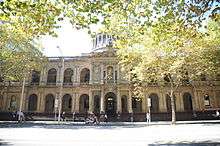
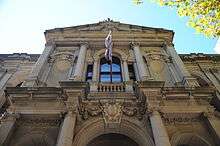
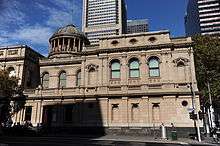
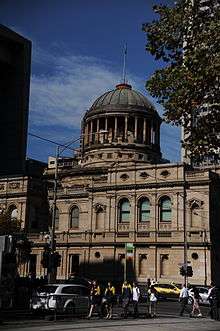
Locations
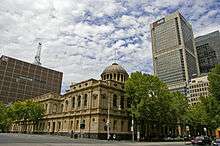
The main buildings for the Supreme Court are located at the corner of William and Lonsdale Streets in Melbourne and in nearby buildings.[3]
The Supreme Court also does circuits to Ballarat, Geelong, Warrnambool, Hamilton, Horsham, Bendigo, Mildura, Shepparton, Wangaratta, Wodonga, Sale and Morwell. In these locations the Court uses the facilities of the local Magistrates' Court.[4]
Current Judges
As of September 2012 (appointment date in brackets):
Chief Justice
- Marilyn Warren (25 November 2003)
President of the Court of Appeal
- Chris Maxwell (18 July 2005)
Judges of the Court of Appeal
- Mark Weinberg (28 July 2008)
- Pamela Tate (16 September 2010)
- Robert Osborn (7 February 2012)
- Simon Whelan (Trial Division from 17 March 2004; 16 October 2012)
- Phillip Priest (23 October 2012)
- Joseph Santamaria (20 August 2013)
- David Beach (Trial Division from 5 September 2008; 22 October 2013)
- Emilios Kyrou (Trial Division from 15 May 2008; 29 July 2014)
- Anne Ferguson (Trial Division from 3 May 2010; 12 August 2014)
- Stephen William Kaye (Trial Division from 2003; 3 February 2015)
- Stephen McLeish (5 March 2015)
Judges of the Trial Division
- Elizabeth Hollingworth (7 June 2004)
- Kevin Bell (10 February 2005)
- Kim Hargrave (18 March 2005)
- Anthony Cavanough (8 May 2006)
- Ross Robson (8 August 2007)
- Jack Forrest (8 August 2007)
- Lex Lasry (23 October 2007)
- James Judd (6 March 2008)
- Peter Vickery (6 May 2008)
- Terry Forrest (13 October 2009)
- Karin Emerton (13 October 2009)
- Clyde Croft (9 November 2009)
- Michael Sifris (19 July 2010)
- Peter Almond (28 July 2010)
- John Dixon (16 September 2010)
- Cameron Macaulay (22 September 2010)
- Kate McMillan (8 March 2012)
- Gregory Garde (30 May 2012)
- Geoffrey John Digby (19 November 2012)
- James Dudley Elliott (25 March 2013)
- Timothy James Ginnane (4 June 2013)
- Melanie Sloss (30 July 2013)
- Michael Croucher (30 July 2013)
- Joanne Cameron (12 August 2014)
- Christopher William Beale (2 September 2014)
- Michael Phillip McDonald (16 September 2014)
- Rita Zammit (3 February 2015)
- Peter Julian Riordan (10 March 2015)
- Jane Dixon (17 August 2015)
- Andrew John Keogh (4 April 2016)
- Peter Barrington Kidd (24 May 2016)
- Maree Evelyn Kennedy (25 July 2016)
See also
- Judiciary of Australia
- List of Judges of the Supreme Court of Victoria
- List of Victorian Supreme Court cases
References
- 1 2 3 4 "Law Courts: 192-228 William Street and 459-505 Lonsdale Street, Melbourne". Walking Melbourne. 2012.
- 1 2 "Building - History: The present Supreme Court building". About the Court. Supreme Court Victoria. 16 October 2012.
- ↑ "Supreme Court of Victoria - Redirect page". Supremecourt.vic.gov.au. Archived from the original on 21 November 2007. Retrieved 2010-07-10.
- ↑ c=AU; st=Victoria; ou1=Department of Justice; ou2=SUPREME. "Supreme Court of Victoria - Regional Courts". Supremecourt.vic.gov.au. Retrieved 2010-07-10.
External links
- Official Supreme Court of Victoria website
- Supreme Court Act (The Act which governs the Supreme Court) (pdf 459kb)
.svg.png)
